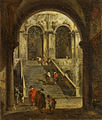Francesco Guardi

Francesco Guardi (* 5. October 1712 in Venice ; † 1. January 1793 ) was an Italian vistas - and landscape painter of the Rococo .
Life
Francesco Guardi was a son of the northern Italian baroque painter Domenico Guardi (1678-1716) from Trentino and Maria Claudia Pichler. His brothers were Giovanni Antonio Guardi (1699-1760) and Nicolò Guardi , his sister Cecilia Guardi married Giovanni Battista Tiepolo (1696-1770), who in 1756 became chairman of the academy. Francesco Guardi was a member there since 1747. He again trained his son Jacopo to be a painter.
Until the death of his brother Antonio in 1760, Francesco worked in the family's painting workshop, in which the younger brother Nicolò also worked. At the beginning of his career he first painted altarpieces, but as a pupil and successor of Canaletto he concentrated on vedute after he had left the city . He initially chose the same motifs, especially Venetian views, which Canaletto had already painted many times and with great success. However, his pictures differ from those of the late Canaletto by mostly lively light and shadow effects, a dramatically heightened, free and impulsive painting style with partly impasto application of paint, which seems to anticipate impressionistic painting - also in the feeling for light and color. In contrast to Canaletto, Guardi adhered less precisely to topographical conditions in favor of a painterly effect. Some of his paintings are capriccios , painterly compilations of both existing and invented architectures and landscapes.
Guardi received orders from private patrons and from the Republic of Venice , such as the cycle of twelve festivals for the Doge Alvise IV. Mocenigo . In 1782 he documented the visit of Pope Pius VI in four paintings . in Venice. On the occasion of the visit of the Russian grand dukes to the city, he painted the festivities that were held in their honor. Pictures like these are valuable art historical testimonies about life and everyday life, but also celebrations in Venice in the 18th century.
In addition to the vedute and images of Venetian festivals, Guardi also has a large number of genre scenes, such as the conference room of the nuns of San Zaccaria , which give a vivid and colorful picture of the fashions, customs and traditions of the Venetian aristocracy.
His pictures have clear, even lighting and are characterized by their atmospheric atmosphere. They are stronger and richer in color than those of his teacher, but less detailed in the drawing. Despite such differences, his paintings have repeatedly been attributed to his more famous teacher.
Guardi was one of the first artists to paint paintings of current events.
Works
- Gate to the Arsenal in Venice
- Piazza San Marco with a view of the basilica , around 1760
- View of the Grand Canal from Palazzo Balbi ; Approx. Rezzonico in Venice,
- Concert in honor of the Russian grand princes , 1782, Munich, Alte Pinakothek
- The balloon ascent of Count Zambeccari 1784 , Berlin, Staatliche Gemäldegalerie
- The conference room , Ca 'Rezzonico in Venice
- The Doge Alvise IV. Mocenigo on the Bucintoro near San Nicolò in Lido , Paris, Louvre
- The Feast of Corpus Christi in the Piazzetta , 1782
- The fire in the district of San Marcuola , 1789
The nuns' office in the monastery of San Zaccaria ; Ca 'Rezzonico
Concert in the Alte Prokuratien
Munich, Alte Pinakothek
Exhibitions
- Francesco Guardi . A cura die Alberto Craievich e Filippo Pedrocco. Venice Museo Correr 2012.
literature
- Constantin von Wurzbach : Guardi, Francesco . In: Biographisches Lexikon des Kaiserthums Oesterreich . 6th part. Imperial-Royal Court and State Printing Office, Vienna 1860, p. 7 f. ( Digitized version ).
- Michele Di Monte: Guardi, Francesco. In: Mario Caravale (ed.): Dizionario Biografico degli Italiani (DBI). Volume 60: Grosso – Guglielmo da Forlì. Istituto della Enciclopedia Italiana, Rome 2003.
- Cornelia Friedrichs: Francesco Guardi. Venetian festivals and ceremonies . Deutscher Kunstverlag, Munich 2006, ISBN 3-496-01353-2
Web links
- Works by Francesco Guardi at Zeno.org .
- Short biography at The J. Paul Getty Museum, Los Angeles (engl.)
- Francesco Guardi at artcyclopedia.com (engl.)
- Exhibition Francesco Guardi - 1712/1793 from September 29, 2012 to February 17, 2013 at the Museo Correr, Venice (English)
Individual evidence
- ↑ Ingeborg Wiensowski: Canaletto exhibition: Do not Look colors . On Spiegel Online from October 12, 2010.
- ↑ S. Partsch: Look me in the eye, Dürer! The art of the old masters. Munich 2018. p. 249.
- ↑ Reinhard J. Brembeck: This painter is not interested in accuracy - the vedute painter Francesco Guardi in the Museo Correr, in the Süddeutsche Zeitung of January 4, 2013
| personal data | |
|---|---|
| SURNAME | Guardi, Francesco |
| BRIEF DESCRIPTION | Italian rococo vedute and landscape painter |
| DATE OF BIRTH | October 5, 1712 |
| PLACE OF BIRTH | Venice |
| DATE OF DEATH | January 1, 1793 |
| Place of death | Venice |




